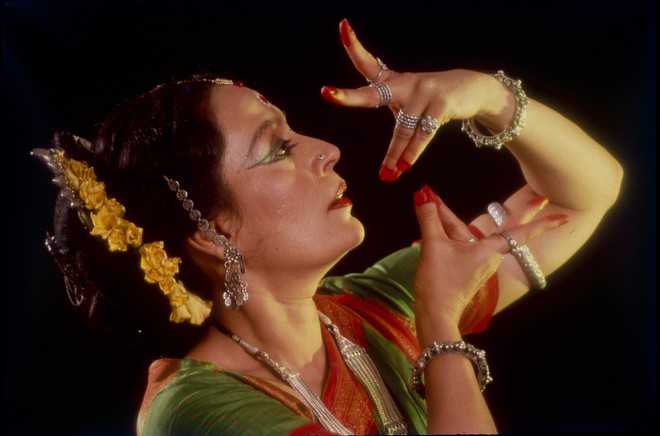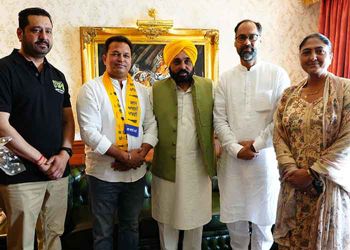
Gurnaaz Kaur
Just as we begin the conversation, Sonal Mansingh, a name well-known in the arena of Indian classical dance, says, “All art forms were created conceptualised to educate and not just entertain.” She insists artistes have the responsibility to concentrate on the wide scene of art. “And it’s not just dance, music, poetry, painting, sculpture, languages and philosophy, all are branches of the same tree. They are all connected with the same roots and thus their purpose becomes one,” says the danseuse.
In her 54-year career, Sonal Mansingh has experienced growth that transcends the obvious and she feels every artist is capable of it. “I am not what I was 15 or 20 years ago and my work reflects that. I’ve grown and so have my performances. I have crossed the known territories and ventured into something new each time, and this hasn’t come easy,” she smiles.
So, what is the new, the not-so-easy and how has it happened? “You have to critique yourself. There is a lot of thinking and rethinking involved. I knew just one thing: my dance should convey my growth and that meant letting go of comfort zones. For, comfort zones numb your mind, they don’t speak anything about you, and they don’t let you speak.” “As artistes, once we get recognised for a certain art form, we let it become our identity, calling it our niche. But I feel it is a sign that it is time to break the mould and find a new space for yourself. Art means expansion. Then why confine oneself to a particular form or role?” she questions.
Celebrated for Odissi, Bharatnatyam, Kuchipudi and Chhau, her choreography takes her places. She also enjoys teaching these dance forms, but this isn’t it for her. Sonal Mansingh has been working to add a new flavour to her creation. She says it is the art of telling stories embellished with her own singing, narrative skills and expressive communication through hand gestures, words and a face that reflects myriad emotions. These are stories that are relevant, that touch a nerve with the young and old alike. Sonal calls it Naatya Katha. “My role as an educator has added Naatya Katha to my repertoire. I am now focussing on issues concerning women, environment, prison reforms and re-interpretation of ancient myths,” she shares. But what’s topical about myths, we ask. “Mythology does not suffice the meaning. Indian mythology is not really a myth, since myth is half-truth or fairytale-like. The right word is Purana. Purana means collective memory of the people living in those times. Myths evaporate over time, but the lessons of our puranas are quite pertinent because the stories are real,” she says.
The latest story that has been keeping Sonal on her toes is Stree. This story is close to her heart and she has spent years in research, reading Rig Veda, the Upanishads and all the contemporary writings on women. “Stree is a sanskrit word, which is used as a synonym for woman in Hindi. But words like nari and abla are also used as its synonyms. There is a huge difference in the meanings of these words and I am making an effort to explain the difference,” the danseuse affirms.
“While the meaning of stree in shastra is the one who has sweet shabd (word), one who is capable of creating; abla means the one with no strength and nari means one who follows the Narad, the male. We have been using nari and abla so often, why not use stree? It’s because we are living in a patriarchal society. In this male dominated society, words have become empty shells and there is so much verbosity all around. No one wants to delve into the actual meaning of words,” says Sonal, with a sense of disappointment.
Unhappy about the times, Sonal blames the dependency on internet and Google that has replaced real teachers. “Everyone is so attuned to Wikipedia. Google is the new God. It’s complete nonsense. The state of our youth worries me. If my art and research put together can inculcate the right meanings to even a few minds, I’ve lived the story well,” Sonal smiles.
The conversation touches its goodbye note, but we can’t resist asking that one last question. What is it you enjoy doing more, the dance performances or reciting stories? And pat comes the answer, “I’ve danced for 55 years, they’ve had themes too. But I was bound by the costume, ghungroo, makeup and time. In Natya Katha, I am explaining all the performances I’ve done so far. I am singing, I am narrating, and there is a continuous flow. It is an elastic form of what I’ve always been doing. Just that makeup is no compulsion and I can add words to my moves. But my real purpose remains the same; it is to narrate brahma vakya, the truth of all times, as artistically and meaningfully as I can.”



























